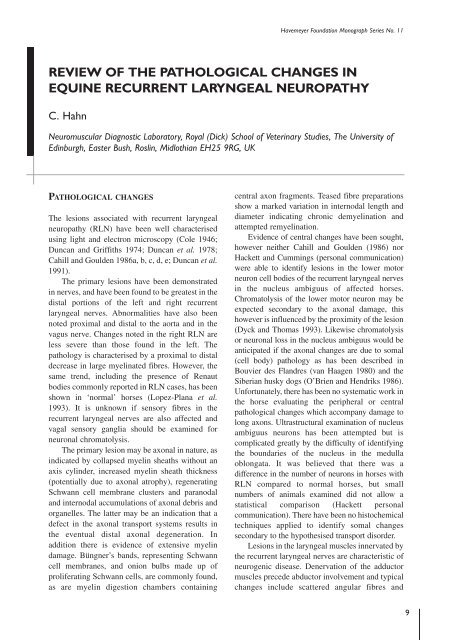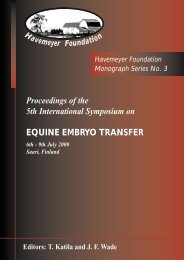Proceedings of a Workshop on - The Havemeyer Foundation
Proceedings of a Workshop on - The Havemeyer Foundation
Proceedings of a Workshop on - The Havemeyer Foundation
Create successful ePaper yourself
Turn your PDF publications into a flip-book with our unique Google optimized e-Paper software.
<strong>Havemeyer</strong> Foundati<strong>on</strong> M<strong>on</strong>ograph Series No. 11<br />
REVIEW OF THE PATHOLOGICAL CHANGES IN<br />
EQUINE RECURRENT LARYNGEAL NEUROPATHY<br />
C. Hahn<br />
Neuromuscular Diagnostic Laboratory, Royal (Dick) School <str<strong>on</strong>g>of</str<strong>on</strong>g> Veterinary Studies, <strong>The</strong> University <str<strong>on</strong>g>of</str<strong>on</strong>g><br />
Edinburgh, Easter Bush, Roslin, Midlothian EH25 9RG, UK<br />
PATHOLOGICAL CHANGES<br />
<strong>The</strong> lesi<strong>on</strong>s associated with recurrent laryngeal<br />
neuropathy (RLN) have been well characterised<br />
using light and electr<strong>on</strong> microscopy (Cole 1946;<br />
Duncan and Griffiths 1974; Duncan et al. 1978;<br />
Cahill and Goulden 1986a, b, c, d, e; Duncan et al.<br />
1991).<br />
<strong>The</strong> primary lesi<strong>on</strong>s have been dem<strong>on</strong>strated<br />
in nerves, and have been found to be greatest in the<br />
distal porti<strong>on</strong>s <str<strong>on</strong>g>of</str<strong>on</strong>g> the left and right recurrent<br />
laryngeal nerves. Abnormalities have also been<br />
noted proximal and distal to the aorta and in the<br />
vagus nerve. Changes noted in the right RLN are<br />
less severe than those found in the left. <strong>The</strong><br />
pathology is characterised by a proximal to distal<br />
decrease in large myelinated fibres. However, the<br />
same trend, including the presence <str<strong>on</strong>g>of</str<strong>on</strong>g> Renaut<br />
bodies comm<strong>on</strong>ly reported in RLN cases, has been<br />
shown in ‘normal’ horses (Lopez-Plana et al.<br />
1993). It is unknown if sensory fibres in the<br />
recurrent laryngeal nerves are also affected and<br />
vagal sensory ganglia should be examined for<br />
neur<strong>on</strong>al chromatolysis.<br />
<strong>The</strong> primary lesi<strong>on</strong> may be ax<strong>on</strong>al in nature, as<br />
indicated by collapsed myelin sheaths without an<br />
axis cylinder, increased myelin sheath thickness<br />
(potentially due to ax<strong>on</strong>al atrophy), regenerating<br />
Schwann cell membrane clusters and paranodal<br />
and internodal accumulati<strong>on</strong>s <str<strong>on</strong>g>of</str<strong>on</strong>g> ax<strong>on</strong>al debris and<br />
organelles. <strong>The</strong> latter may be an indicati<strong>on</strong> that a<br />
defect in the ax<strong>on</strong>al transport systems results in<br />
the eventual distal ax<strong>on</strong>al degenerati<strong>on</strong>. In<br />
additi<strong>on</strong> there is evidence <str<strong>on</strong>g>of</str<strong>on</strong>g> extensive myelin<br />
damage. Büngner’s bands, representing Schwann<br />
cell membranes, and <strong>on</strong>i<strong>on</strong> bulbs made up <str<strong>on</strong>g>of</str<strong>on</strong>g><br />
proliferating Schwann cells, are comm<strong>on</strong>ly found,<br />
as are myelin digesti<strong>on</strong> chambers c<strong>on</strong>taining<br />
central ax<strong>on</strong> fragments. Teased fibre preparati<strong>on</strong>s<br />
show a marked variati<strong>on</strong> in internodal length and<br />
diameter indicating chr<strong>on</strong>ic demyelinati<strong>on</strong> and<br />
attempted remyelinati<strong>on</strong>.<br />
Evidence <str<strong>on</strong>g>of</str<strong>on</strong>g> central changes have been sought,<br />
however neither Cahill and Goulden (1986) nor<br />
Hackett and Cummings (pers<strong>on</strong>al communicati<strong>on</strong>)<br />
were able to identify lesi<strong>on</strong>s in the lower motor<br />
neur<strong>on</strong> cell bodies <str<strong>on</strong>g>of</str<strong>on</strong>g> the recurrent laryngeal nerves<br />
in the nucleus ambiguus <str<strong>on</strong>g>of</str<strong>on</strong>g> affected horses.<br />
Chromatolysis <str<strong>on</strong>g>of</str<strong>on</strong>g> the lower motor neur<strong>on</strong> may be<br />
expected sec<strong>on</strong>dary to the ax<strong>on</strong>al damage, this<br />
however is influenced by the proximity <str<strong>on</strong>g>of</str<strong>on</strong>g> the lesi<strong>on</strong><br />
(Dyck and Thomas 1993). Likewise chromatolysis<br />
or neur<strong>on</strong>al loss in the nucleus ambiguus would be<br />
anticipated if the ax<strong>on</strong>al changes are due to somal<br />
(cell body) pathology as has been described in<br />
Bouvier des Flandres (van Haagen 1980) and the<br />
Siberian husky dogs (O’Brien and Hendriks 1986).<br />
Unfortunately, there has been no systematic work in<br />
the horse evaluating the peripheral or central<br />
pathological changes which accompany damage to<br />
l<strong>on</strong>g ax<strong>on</strong>s. Ultrastructural examinati<strong>on</strong> <str<strong>on</strong>g>of</str<strong>on</strong>g> nucleus<br />
ambiguus neur<strong>on</strong>s has been attempted but is<br />
complicated greatly by the difficulty <str<strong>on</strong>g>of</str<strong>on</strong>g> identifying<br />
the boundaries <str<strong>on</strong>g>of</str<strong>on</strong>g> the nucleus in the medulla<br />
obl<strong>on</strong>gata. It was believed that there was a<br />
difference in the number <str<strong>on</strong>g>of</str<strong>on</strong>g> neur<strong>on</strong>s in horses with<br />
RLN compared to normal horses, but small<br />
numbers <str<strong>on</strong>g>of</str<strong>on</strong>g> animals examined did not allow a<br />
statistical comparis<strong>on</strong> (Hackett pers<strong>on</strong>al<br />
communicati<strong>on</strong>). <strong>The</strong>re have been no histochemical<br />
techniques applied to identify somal changes<br />
sec<strong>on</strong>dary to the hypothesised transport disorder.<br />
Lesi<strong>on</strong>s in the laryngeal muscles innervated by<br />
the recurrent laryngeal nerves are characteristic <str<strong>on</strong>g>of</str<strong>on</strong>g><br />
neurogenic disease. Denervati<strong>on</strong> <str<strong>on</strong>g>of</str<strong>on</strong>g> the adductor<br />
muscles precede abductor involvement and typical<br />
changes include scattered angular fibres and<br />
9








